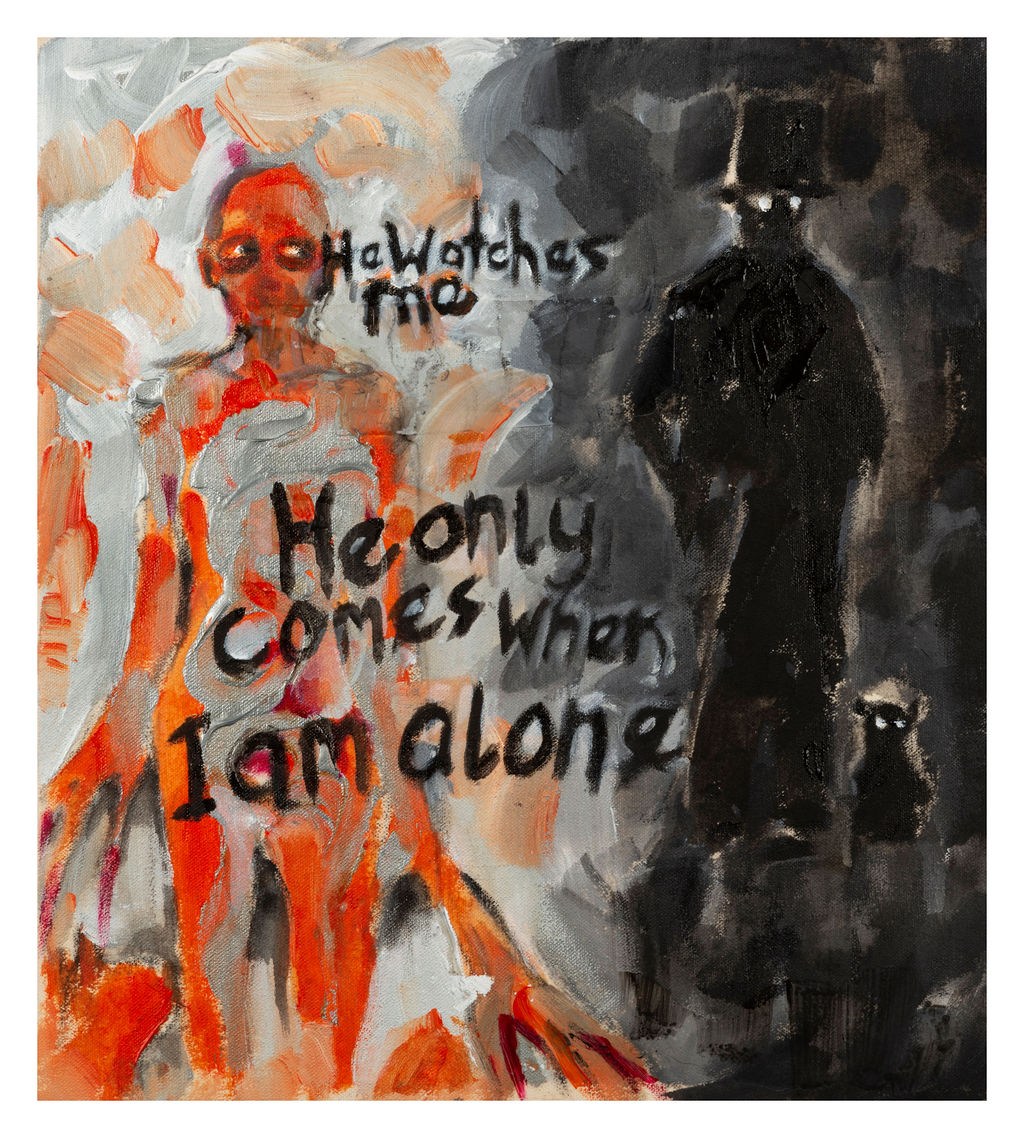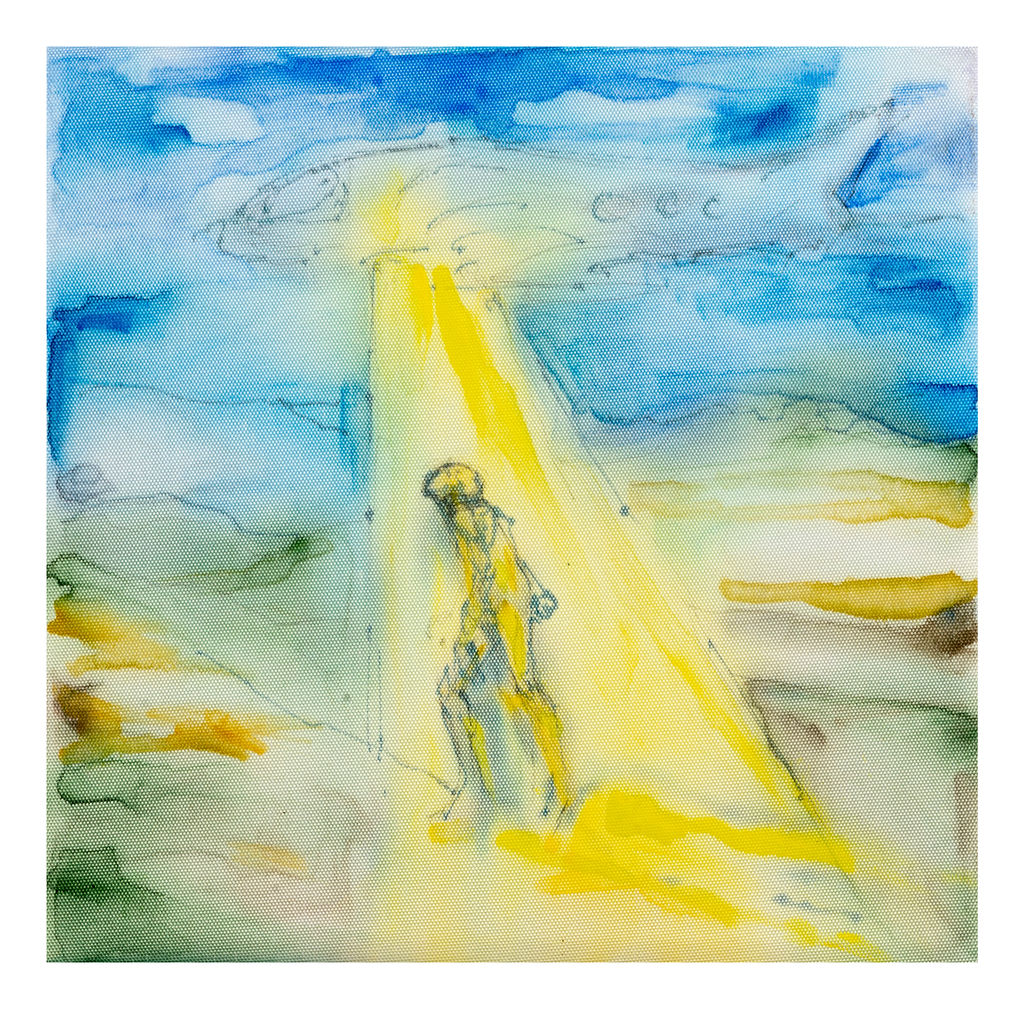Artist
Jenny Souter

Jenny Souter’s practice investigates a dialogue of perception that is primarily based on what it is ‘to be human’. Having recently finalised a BA and an MA at Cambridge School of Art, Jenny intends to focus on further research and independent projects, utilising the knowledge she has gained.
The theory of Antonio Damasio is a dominant feature in supporting narrative alongside the artwork. The art pieces made are, paintings, film, and sound. Sound as a particular media interest her, for its physical properties, which induce a somatic ‘felt- affect’.
Sound cloud link: Stream Jenny Souter music
Vimeo link: jenny souter (vimeo.com)
Facebook: Jenny Souter Fineart
Instagram: @souterjenny
He Only comes When I Am Alone
Condition: Parkinson’s Disease
Acrylic on canvas, 39cm x 44cm
‘The unconscious is inexhaustible and uncontrollable. Its force surpasses us. It is as mysterious as the last particle of a brain cell. Even if we knew it, we could not reconstruct it.’ (Tzara, T.1922).
This image is a response to meetings on zoom with a patient suffering from Parkinson’s disease.
The narrative of painting is a layered dialogue. This art piece is an attempt to portray a felt experience exploring a specific hallucination, one that involves a male Victorian funeral bearer, like an image often portrayed as a ‘grim reaper’.
I have become a witness, the patient in the painting is facing me, there are now three people in the room or art piece, myself, the patient, and the vision.
As I face the patient witnessing the hallucination, I hear the dialogue between the patient and myself.
‘I am the colour, colour is safe’ ‘He is the shadows. My response to these words is fill the patient with colour. I asked, ‘what do you do when he appears?’ the answer was; ‘I centre myself and remain calm, then I begin to realise he is not real’. I have intentionally made the arms and hands and fingers longer, trailing and seeking the ground in an urgent quest for stability, pursuing what is real and felt through the body.
The coloured figure emerges, in a standing position, facing me with only the eyes, twisted sideways, seeing the funeral bearer from a peripheral viewpoint. The eyes navigate what is around us to ‘make sense’ or decipher information for survival, and that evidence is processed first.
The image, projected out of the mind, becomes strengthened when it has been defined. He has been given an identity, personality and assigned to his place as a threat rather than a gain. The character has had a verb applied to it, ‘he watches me’, this is one of power over the patient.
The words became more influential to me and it is for that reason I have included them in the painting. They are hand painted to reveal a sense of self and feeling rather than a documented format, which implies authority and constitution.
The language dictates an emotion of fear and a questioning of ‘self’. ‘He watches me’. ‘Why does he watch you’, I asked? ‘He is waiting for me.’ This potential threat to self becomes evident because the figure has become individualised.
The patient knows he is not real but still fears him. I asked, ‘do you call a friend?’ The patient replied, ‘no, I would be worried about what they would think of me’.
Upon reflection, it occurred to me that the patient must not only feel judged by the figure, but in addition, potentially by other people.
The courage of the patient in the first instance, to relay her experiences to a stranger is enabling, and secondly, to remain calm to ‘place him as unreal’, when the mind has told her he is actual is empowering.
The ‘knowing that we know’ part of ourselves, wins through and the reoccurring temporary battle is won.
Quotes from participant with Parkinson’s
“One is, that I see a Victorian gentleman standing next to me, top hat and tails and black chiffon around it, and he has a black dog next to him which doesn’t move. But I’ve recently cut back on my medication and since I did that, he’s gone, which I’m glad about, because he’s quite sinister.”
“There’s never any speech in the hallucinations at all. They don’t talk, people don’t talk to me.”
“And you sort of think, it’s so strange. And then it bothers you to begin with, but then I know I get them, so if I just calm down, I can think rationally. […] I realize they’re not real, and at the point I realize they’re not real, they go.”
“The color is a reassuring thing for me, looking at that. […] For me, normality is the color and the hallucinations are the dark.”
“I suppose, I don’t feel other people will understand what I’m seeing. And it could make them then look at me in a different light.”
I Followed The White Lines In The Sky
Condition: Schizophrenia
Watercolour and ink on stretched canvas, 40cm x 40cm.
The patient said, ‘one day I followed the white lines in the sky for miles. The white lines came from the aeroplane that was following me. I thought that if I tracked them to the end, they would stop pursuing me and leave me alone. I trailed them for miles and miles all day until it went dark, and I couldn’t see them anymore, after that I went home’.
The painting I have chosen to make is a cohesion between two primary sketches, one of an aeroplane and the patient underneath enveloped by an ethereal mosquito net, and the other is a sketch of the patient walking looking at the sky. In both sketches the patient is predominantly yellow, because that is the colour the patient identifies with as a sense of self.
Utilising materials that explained an ethereal state of being, I have used watercolours and a type of material that dissipated the colours leading to a blur. This ‘blur’ signifies and mirrors how I see the side that ‘self-questions’ that is, to some extent controlled by the visions and voices that are seen and heard. The mosquito-type net that is connected to the patient, also reinforces the relationship between the aeroplane and the patient, one cannot be without the other.
The patient in the painting is looking upwards at the aeroplane, whilst continually walking, the fists are clenched in a determination to strive forwards and not give up, (I walked for miles and miles all day, until it was dark). The patient is yellow and also the connection to the aeroplane, in addition to the patient’s shadow, which can be defined as a concrete sense of self.
Quotes from participant with Schizophrenia
“It’s frightening more than any feeling, because I couldn’t understand how they[the voices] were getting in there.”
“They[the voices] used to tell me to check everything in the house before I left. […] Or, you know, all that, I mean I was a little petrified once because they told me that there’s a helicopter above the house, and they told me that the helicopter was spying on me. And the helicopter, it was real, it was hovering above the house, and I thought, ‘Christ, I gotta get out of here’.”
“I’ve followed airplanes as well. […] You know, like the white paper lines that they sometimes, the engine leaves in the sky. […] Well I’ve followed them, they took me all over East Anglia. That was, that was quite a day out, that was.”
“I was getting messages from newspapers, magazines. And, it was getting quite frightening. You know, ’cause for some reason I used to pick out the most detrimental sentence in the whole paper and dwell on it, you know. Or the most detrimental headline and then dwell on that and then, uhm, yeah, I getting quite paranoid, actually.”


